“We are very good at developing novel optofluidic devices for research demonstrations; the challenges lie in transitioning these devices into commercially viable products.” – Arthur Nitkowski, Cornell University
Optofluidics is a relatively young field
but is growing rapidly to serve applications from analysis of biomolecules and cells
to creation of novel optical switches and lasers. The discipline has emerged in
only the past five or six years as two other important fields – microfluidics
and nanophotonics – have reached their peak in terms of technology development,
leading researchers to explore ways to combine their respective strengths into a
single package.
Optofluidics technologies are evolving, said David Erickson, director
of the Integrated Nanofluidic Systems Lab in the Sibley School of Mechanical and
Aerospace Engineering at Cornell University in Ithaca, N.Y. Indeed, many new technologies
are already very mature at the lab scale, he said. The next step is to develop them
for real-world, large-scale applications.
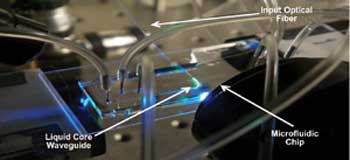
David Erickson of Cornell University, along with Dr. Bernardo Cordovez, recently launched Optofluidics Inc. to develop products such as switches for biotechnology applications. Using fluids and optics together, Erickson said, might enable new forms of reconfigurable photonics.
A number of groups are developing optofluidic technologies for
lab-on-a-chip applications. Also at Cornell, Arthur Nitkowski, Antje Baeumner and
Michal Lipson designed and built a microscale optofluidic device that measures optical
absorption in color-producing enzymatic reactions for biochemical analysis. As reported
in the Feb. 1, 2011, issue of Biomedical Optics Express, this employs cavity-enhanced
laser spectrophotometry to probe analytes in a microfluidic channel with silicon
nitride microring resonators.
The device addresses a challenge often encountered with similar
technologies. “Many researchers have used optical microcavities as refractive
index sensors to measure binding events on the surface of a waveguide,” Nitkowski
said. “Those devices work by measuring the shift in resonance wavelength of
a microcavity, but this shift can be caused by nonspecific binding or thermal fluctuations.”
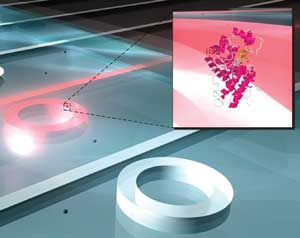
Researchers at Cornell University recently described a microscale optofluidic device for biochemical analysis. With this device, cavity-enhanced spectrophotometry is performed on analytes in a microfluidic channel with microring resonators. Shown on left is an array of such resonators within a microfluidic channel. The small dots are enzymes; the rings are sensitive to
color changes produced in the microchannel by the enzymes. Courtesy of Arthur Nitkowski.
Microfluidic cytometry
The investigators showed that they could measure the unique spectral
signature of the analyte itself, eliminating the need to alter the surface of the
ring to facilitate the binding of specific biological targets. They achieved this
by using high-quality factor microcavities with high-index contrast materials. Low
losses in the cavities allowed light to propagate many times around the circumference
of the ring, thus extending the effective optical path length of the device.
At the University of Alberta in Edmonton, Canada, Xuantao Su and
colleagues are looking into optofluidic technology to aid in the development of
the next generation of portable cytometers for point-of-care and other applications.
Current commercially available flow cytometers employ multiple lasers and detectors,
leading to a complex system that is expensive and massive, Su said. To achieve its
goal, Su’s group had to compress the light excitement and detection system
found in existing cytometers.
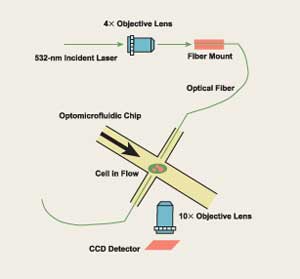
At the University of Alberta, researchers reported a microscope-based
label-free microfluidic cytometer that enables differentiation of normal
from cancerous cells, for example, through analysis of 2-D light-scattering patterns.
A schematic of the device is shown here. Courtesy of Xuantao Su.
In the Jan. 3, 2011, issue of Optics Express, the researchers
– including Ying Y. Tsui, Wojciech Rozmus and Anna Janowska-Wieczorek –
reported a microscope-based label-free microfluidic cytometer that could serve
as a prototype for point-of-care clinical applications.
The system allows non-imaging observation of single cells, enabling
differentiation of normal from cancerous cells through analysis of 2-D light-scattering
patterns. This was made possible by incorporating a microscope objective into the
cytometer which, in defocusing mode, functions in a way that is contrary to how
these objectives are normally used, Su said. The numerical aperture of the optical
objective improves the signal-to-noise ratio of light-scattering detection, enabling
the system to obtain patterns from platelets, the smallest mature human blood cells.
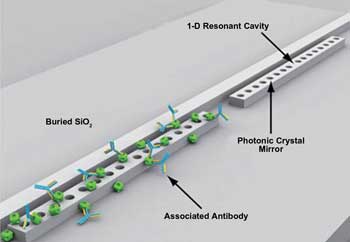
Optofluidic sensors represent the next generation of molecular detectors and may find application for cancer diagnostics. Courtesy of David Erickson.
Optofluidic evolution
Su recently moved to Shandong University in Jinan, China, where
as principal investigator he leads an interdisciplinary team exploring optofluidic
technology for the next generation of portable instruments.
Having developed and successfully demonstrated a broad range of
technologies, the optofluidics community can now also look toward commercialization
of those technologies.
“We are very good at developing novel optofluidic devices
for research demonstrations; the challenges lie in transitioning these devices into
commercially viable products,” said Nitkowski, who now works with a startup
company developing nanophotonic devices for spectroscopy applications.
To achieve this, he said, developers of the technology essentially
need to divorce lab-on-a-chip devices from traditional laboratory equipment like
microscopes, pumps and sample-prep instruments. “Optofluidics plays an important
role here, but more functionality (electrical, pneumatic, etc.) needs to be integrated
to develop stand-alone devices.”
Erickson agrees that transitioning from the lab to the marketplace
is the next step in the evolution of optofluidics. “We’re building a
lot of demonstrative devices in the lab,” he said, “but the major challenges
of the 21st century – the grand challenges – are all about big things:
desalinization and energy, for example. The question now is, ‘How do we take
advantage of physics at the micro- or nanoscale but upscale it so it’s useful
for these large-scale applications?’ ”
Global health challenges
A new generation of researchers is also working to develop optofluidic
technologies, using them to address some of the most serious challenges of the still-young
century.
In March, Guoan Zheng, a graduate student at the California Institute
of Technology in Pasadena, was awarded the $30,000 Lemelson-MIT Caltech Student
Prize in recognition of a simple, cost-effective, high-resolution on-chip microscope
he designed – called the subpixel resolving optofluidic microscope. The instrument
has a range of potential applications, particularly in the developing world. These
include improved diagnosis of malaria and detection of blood-borne and water-borne
parasites.
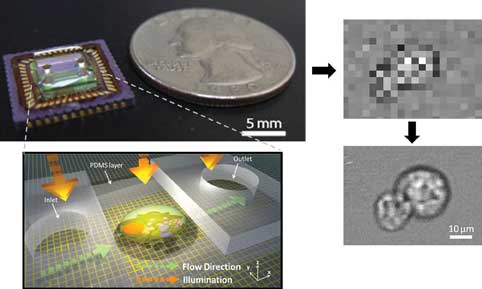
The subpixel resolving optofluidic microscope, designed by Guoan
Zheng, could contribute to a number of point-of-care applications in the developing world.
Courtesy of Guoan Zheng.
The microscope uses oversampling in the time domain to compensate
for undersampling in the spatial domain; this is made possible by applying a superresolution
algorithm. The basic principle of this image-enhancement technique is to get one
high-resolution image from several low-resolution images, Zheng said.
Zheng and his colleagues continue to develop the optofluidic microscope.
For example, they are planning to implement a new, more robust version using glass-based
microfluidic channels integrated at the wafer level. They also are looking to incorporate
additional imaging modalities onto the current platform, he said, including dark-field
and phase imaging capabilities.
Providing health care in the developing world – in what
are often described as “resource-limited settings” – is an important
potential application of optofluidic devices. Accurate diagnosis is needed for treatment
and prevention of a number of infectious diseases as well as for monitoring of health
conditions, but this must be achieved without the trained personnel, established
infrastructure and costly medical instruments found in the developed world.
Creating technologies for use in resource-limited settings involves
a range of challenges. Most importantly, devices must be inexpensive, portable and
easy to use but as robust as technologies used in clinical settings in developed
nations.
“At the end of the day, the performance has to be comparable
to that of the gold standard,” said Utkan Demirci, director of the Bio-Acoustic-MEMS
in Medicine (BAMM) Laboratory at Brigham and Women’s Hospital and Harvard
Medical School in Boston. The BAMM Lab develops microfluidics for low-cost CD4 counts
and viral load detection for HIV in resource-limited settings for global health
problems. “The information it provides has to be clinically relevant.”
Pushing development
Developers must consider a host of other factors, though. Since
they are to be used at the point of care in resource-limited settings, the devices
must be able to function under high heat and humidity, and must be able to withstand
electrical outages, for example. Also, because patient populations are likely to
be found in remote locations, the technologies must be rugged enough to survive
lengthy rides or walks – often across difficult terrain – while stuffed
in a backpack.
And even if they come up with a device that can achieve all this,
developers may face challenges in commercializing it.
“If you are building a company in, say, Boston, the route
is more clear,” Demirci said. “One can reach who the stakeholders are
in the marketplace; you know who the buyers are. But if you are developing a technology
for resource-limited settings, you have to figure out who the customer is, and who
is going to fund it.”
Getting to know the nongovernmental and governmental organizations
working in these areas is essential, he said. Also, in recent years, social entrepreneurship
and social capital concerns have begun to support such efforts. One example: the
Bill & Melinda Gates Foundation which, in late April, announced 88 new global
health projects to be funded by its Grand Challenges Explorations grants.
“Although there are challenges, the needs are apparent for
rapid diagnostic and monitoring technologies for the point of care,” he said.
“Some of these technologies may also later contribute positively to the cost
of health care and health care economics in the resource-rich settings.”